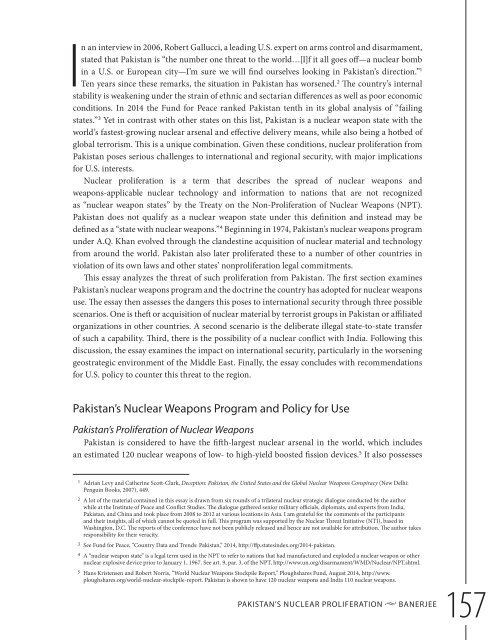pakistan’s
SR55_Mapping_Pakistan_February2016
SR55_Mapping_Pakistan_February2016
You also want an ePaper? Increase the reach of your titles
YUMPU automatically turns print PDFs into web optimized ePapers that Google loves.
In an interview in 2006, Robert Gallucci, a leading U.S. expert on arms control and disarmament,<br />
stated that Pakistan is “the number one threat to the world…[I]f it all goes off—a nuclear bomb<br />
in a U.S. or European city—I’m sure we will find ourselves looking in Pakistan’s direction.” 1<br />
Ten years since these remarks, the situation in Pakistan has worsened. 2 The country’s internal<br />
stability is weakening under the strain of ethnic and sectarian differences as well as poor economic<br />
conditions. In 2014 the Fund for Peace ranked Pakistan tenth in its global analysis of “failing<br />
states.” 3 Yet in contrast with other states on this list, Pakistan is a nuclear weapon state with the<br />
world’s fastest-growing nuclear arsenal and effective delivery means, while also being a hotbed of<br />
global terrorism. This is a unique combination. Given these conditions, nuclear proliferation from<br />
Pakistan poses serious challenges to international and regional security, with major implications<br />
for U.S. interests.<br />
Nuclear proliferation is a term that describes the spread of nuclear weapons and<br />
weapons-applicable nuclear technology and information to nations that are not recognized<br />
as “nuclear weapon states” by the Treaty on the Non-Proliferation of Nuclear Weapons (NPT).<br />
Pakistan does not qualify as a nuclear weapon state under this definition and instead may be<br />
defined as a “state with nuclear weapons.” 4 Beginning in 1974, Pakistan’s nuclear weapons program<br />
under A.Q. Khan evolved through the clandestine acquisition of nuclear material and technology<br />
from around the world. Pakistan also later proliferated these to a number of other countries in<br />
violation of its own laws and other states’ nonproliferation legal commitments.<br />
This essay analyzes the threat of such proliferation from Pakistan. The first section examines<br />
Pakistan’s nuclear weapons program and the doctrine the country has adopted for nuclear weapons<br />
use. The essay then assesses the dangers this poses to international security through three possible<br />
scenarios. One is thet or acquisition of nuclear material by terrorist groups in Pakistan or affiliated<br />
organizations in other countries. A second scenario is the deliberate illegal state-to-state transfer<br />
of such a capability. Third, there is the possibility of a nuclear conflict with India. Following this<br />
discussion, the essay examines the impact on international security, particularly in the worsening<br />
geostrategic environment of the Middle East. Finally, the essay concludes with recommendations<br />
for U.S. policy to counter this threat to the region.<br />
Pakistan’s Nuclear Weapons Program and Policy for Use<br />
Pakistan’s Proliferation of Nuclear Weapons<br />
Pakistan is considered to have the fith-largest nuclear arsenal in the world, which includes<br />
an estimated 120 nuclear weapons of low- to high-yield boosted fission devices. 5 It also possesses<br />
1 Adrian Levy and Catherine Scott-Clark, Deception: Pakistan, the United States and the Global Nuclear Weapons Conspiracy (New Delhi:<br />
Penguin Books, 2007), 449.<br />
2 A lot of the material contained in this essay is drawn from six rounds of a trilateral nuclear strategic dialogue conducted by the author<br />
while at the Institute of Peace and Conflict Studies. The dialogue gathered senior military officials, diplomats, and experts from India,<br />
Pakistan, and China and took place from 2008 to 2012 at various locations in Asia. I am grateful for the comments of the participants<br />
and their insights, all of which cannot be quoted in full. This program was supported by the Nuclear Threat Initiative (NTI), based in<br />
Washington, D.C. The reports of the conference have not been publicly released and hence are not available for attribution. The author takes<br />
responsibility for their veracity.<br />
3 See Fund for Peace, “Country Data and Trends: Pakistan,” 2014, http://ffp.statesindex.org/2014-pakistan.<br />
4 A “nuclear weapon state” is a legal term used in the NPT to refer to nations that had manufactured and exploded a nuclear weapon or other<br />
nuclear explosive device prior to January 1, 1967. See art. 9, par. 3, of the NPT, http://www.un.org/disarmament/WMD/Nuclear/NPT.shtml.<br />
5 Hans Kristensen and Robert Norris, “World Nuclear Weapons Stockpile Report,” Ploughshares Fund, August 2014, http://www.<br />
ploughshares.org/world-nuclear-stockpile-report. Pakistan is shown to have 120 nuclear weapons and India 110 nuclear weapons.<br />
PAKISTAN’S NUCLEAR PROLIFERATION u BANERJEE<br />
157



